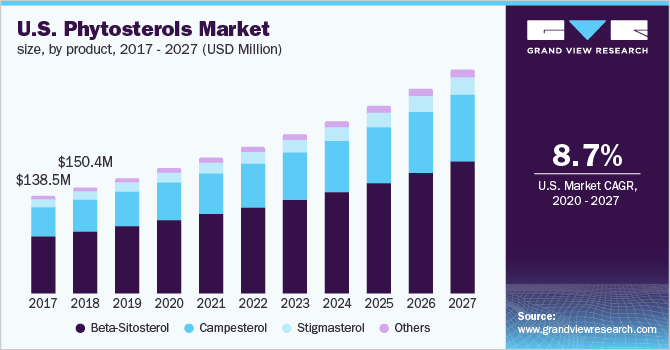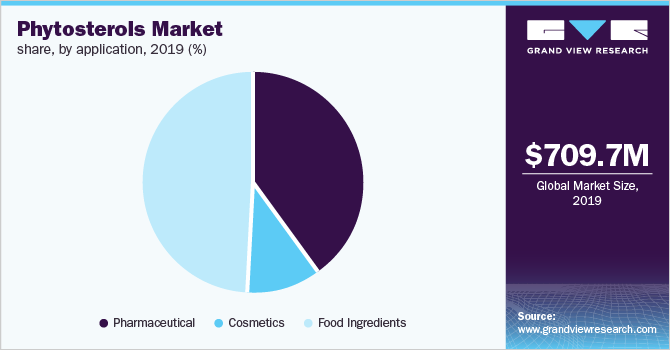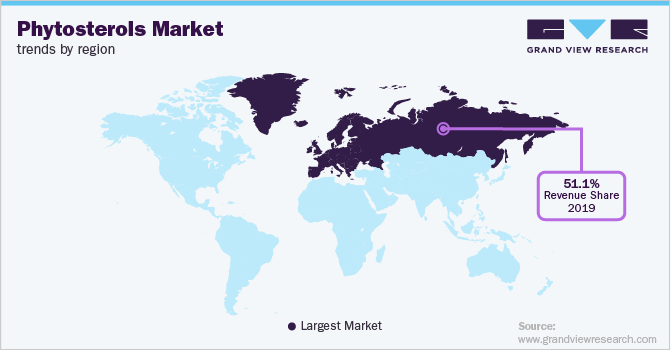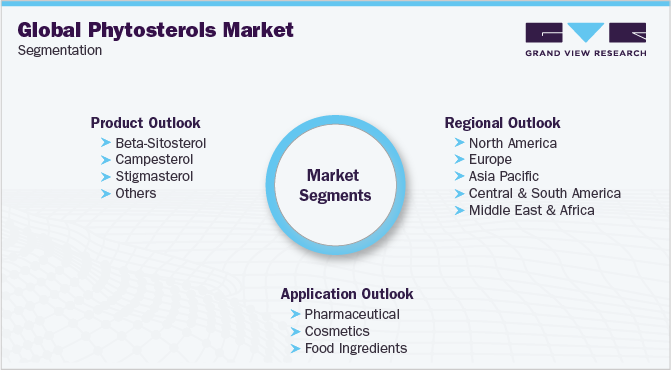- Home
- »
- Nutraceuticals & Functional Foods
- »
-
Phytosterols Market Size, Share, Global Industry Report, 2027GVR Report cover
![Phytosterols Market Size, Share & Trends Report]()
Phytosterols Market Size, Share & Trends Analysis Report By Product (Beta-sitosterol, Campesterol, Stigmasterol), By Application (Pharmaceuticals, Cosmetics, Food Ingredients), By Region, And Segment Forecasts, 2020 - 2027
- Report ID: 978-1-68038-152-8
- Number of Pages: 127
- Format: Electronic (PDF)
- Historical Range: 2016 - 2018
- Industry: Consumer Goods
Report Overview
The global phytosterols market size was estimated at USD 709.66 million in 2019 and is anticipated to grow at a compound annual growth rate (CAGR) of 8.7% from 2020 to 2027. Growing adoption of a healthy lifestyle across the geographies has bolstered the demand for nutraceutical products. This is expected to be one of the prime factors driving the demand for phytosterols.

Ascending demand for dietary supplements complementing cardiovascular health is projected to increase the consumption of phytosterols as a functional ingredient. This is further accelerated by the growing per capita expenditure on healthcare and pharmaceuticals. Smaller profit margins from bio-refineries and vegetable oil extraction are likely to act as a restraining factor against the growth of the market for phytosterols to some extent. However, biotechnological advancement in the near future is projected to boost growth over the forecast period.
Increasing concerns about the impact of conventional chemical ingredients on the environment have prompted the use of bio-based and sustainable ingredients across various industries. The manufacturing sector is shifting its focus toward incorporating bio-based/plant-based raw materials to reduce carbon footprint and gain consumer confidence by providing products having fewer or no side effects.
The cosmetics industry offers a wide range of mature plant-based products owing to the significant rise in demand for bio-based cosmetic products. Phytosterols are used in personal care and cosmetics products, such as anti-aging creams. Plant-based profile of the product coupled with skin-replenishing benefits is projected to foster the growth of the market for phytosterols over the forecast period.
Europe is an early adopter of the bio-based economy. According to a report published by the European Commission on “A sustainable bioeconomy for Europe: strengthening the connection between economy, society, and the environment, the bioeconomy adopted by Europe highly supports the strengthening and modernization of the industrial base in the region by creating new value chains that are greener, more efficient, and cost-effective. The development of biotechnology and related processes has significantly boosted the growth of industries such as cosmetics, in terms of plant-based or bio-based ingredients.
Phytosterols Market Trends
The demand for phytosterols is growing at a steady pace owing to an increase in the consumption of cosmetics, pharmaceuticals, and food products. The demand for personal care products is witnessing growth due to an increase in disposable income, product innovation, and high market penetration. The growing need for biodegradable products is increasing the stringent regulations related to manufacturing, which, in turn, is anticipated to positively influence the phytosterols market growth over the forecast period.
Plant-derived phytosterols are reported to be similar in function and structure to human cholesterol. Several research reports have acknowledged the ability of phytosterols to reduce blood cholesterol levels. The University of Michigan Cardiovascular Center reports that 2-3% of phytosterol consumption on a daily basis can lower LDL cholesterol by up to 10-14%. To get maximum benefits of the product, several food products such as bars, milk, juices, and margarine spreads are fortified with phytosterols. Growing awareness about the product ingredients among the consumers coupled with growing demand for natural plant-based ingredients is expected to be a prime market driver.
Phytosterols isolation is majorly dependent on two primary raw materials, vegetable oils and tall oil. The vegetable oil includes rapeseed, soybean, corn, and sunflower oils. Phytosterols are mainly obtained from the deodorizer distillates, which is a waste product generated during the deodorization process of vegetable oil. The annual production of vegetable oils is increasing continuously majorly dominated by soybean oil.
In the cosmetics industry, a wide variety of mature plant-based products are available on the account of escalating demand for bio-based cosmetic items across the world. Phytosterols are used in personal care and cosmetics products such as anti-aging creams. Therefore, on account of these products being made from plant-derived extracts and their skin-replenishing benefits along with acne treatment, the global phytosterols market is expected to grow.
Several factors such as rapid urbanization, increasing disposable income, and ascending consumer awareness about healthy living have resulted in significant growth of the supplement market, especially in the developed countries of North America and Europe. This is further accelerated by the favorable outlook of consumers and governments toward medical nutrition to protect against the increasing prevalence of cardiovascular and cholesterol-related diseases. In addition, the rising number of weight management programs is another prime factor behind the growing demand for nutritional supplements across geographies.
The pharmaceutical industry is witnessing growth due to the rising prevalence of diseases, and growing healthcare spending. Factors such as huge investments in biotechnology R&D and increasing awareness about stem cell preservation on a global level are expected to boost the consumption of phytosterols in the pharmaceutical industry.
Phytosterols are popularly used in personal care products such as anti-aging creams. The demand for these products is increasing as the geriatric population is becoming more concerned about looks. Other key factors responsible for the growth of the personal care industry include the increasing women population, the younger generation opting for cosmetic products, increased use of acne treatment products by the teenage population, and growing awareness about the benefits of personal care and cosmetic products. These factors are expected to drive the global phytosterols consumption in the personal care & cosmetics industry at a fast pace.
The refining of vegetable oils is a cost-intensive process, and this significantly affects the profit margins of the manufacturers involved in this business. Although there has been notable progress in biotechnology and R&D related to vegetable oil processing and process optimization, the extraction of phytosterols from plants and processing at an industrial scale to cater to the demand from end-use industries are still cost-intensive processes and require huge investments.
Product Insights
Beta-Sitosterol, which can be derived from plant woods and vegetable oils, is significantly used in dairy products, beverages, and as an additive in dietary supplements. Also, a significant number of obese people consume 1.5g to 5g of beta-sitosterol daily for body fat reduction. The growing inclination of consumers towards health and nutritional intake has positively impacted the demand for beta-sitosterol. Consequently, beta-sitosterol is expected to be one of the prominent segments in the market for phytosterols.
Campesterol is used as a food additive and is also marketed as a dietary supplement as it has cholesterol-lowering properties. Increasing demand for phytosterol-fortified nutritional supplements and food products is projected to drive the product demand in the food ingredient segment over the forecast period.
Stigmasterol and its derivatives, including stigmasterol glucoside, stigma-4-en-3-one, spinasterol, fucosterol, and 29-fluorostigmasterol, act as intermediates in the production of vitamin D3. Vitamin D3 is used to prevent bone disorders such as rickets and osteomalacia in humans. Such factors make stigmasterol ideal for pharmaceutical applications. In addition, research activities aimed for the development of stigmasterol in preventing breast and colon cancer are anticipated to open new avenues in the phytosterols market over the forecast period.
Application Insights
Pharmaceutical, cosmetics, and food ingredients are the prominent applications of all phytosterol products. The pharmaceutical segment comprises tablets, creams, and medicinal products. Factors such as increased cholesterol levels among the geriatric population along with the prevalence of lifestyle diseases and other health conditions have fostered the demand for phytosterols in pharmaceutical applications.

In the cosmetics industry, phytosterols derivatives/formulations find application in creams, skincare, sun care, hair care, and oral care products. The outermost layer of skin is made of keratinized cells, which consist of ceramides, free fatty acids, and sterols. The sterols play a significant role in preventing the penetration of exogenous substances through the skin. Moreover, they regulate skin moisture and prevent uncontrolled water loss from human skin. Therefore, the formulation of phytosterols in cosmetic products guarantees healthy and soft skin with a more pleasing appearance.
In the food industry, phytosterols are used as an ingredient in products such as spread, cream, cheese, turkey liver sausage, mayonnaise, chicken balls, yogurt, buttermilk, soymilk, and oatmeal. They are added to the above-mentioned food products owing to their properties to reduce the absorption of bad cholesterol in the gastrointestinal tract, thereby lowering the overall cholesterol level in the human body. Therefore, the demand for phytosterol is expected to boost as a food ingredient owing to its positive health benefits.
Regional Insights
The phytosterol market is segmented on the basis of region into North America, Europe, Asia Pacific, Central, and South America, and Middle East Africa. Europe is anticipated to be one of the fastest-growing regions for phytosterols and is likely to boost at a significant rate over the forecast period.The consumption of phytosterols in food has been tested and approved in the European Union, Switzerland, and Norway. In Europe, regulations concerning the ingredients used in food and packaging are comparatively strict. According to the amending Regulation (EC) No 608/2004 of the European Union, particulars regarding food ingredients present in food products with added phytosterols are mandatory in the labeling.

The growth in product demand from Europe is majorly driven by the cosmetics, mature pharmaceutical, and food industries in the U.K. and Germany. The demand is further accelerated by the early adoption of the bio-based alternatives in the region, which in turn, triggered the consumption of bio-based ingredients across various end-use industries.
The end-user industries of phytosterols i.e. pharmaceuticals, cosmetics, and food have witnessed moderate but considerable growth in Europe over the past years. This is majorly driven by the growing utilization of bio-based or plant-based ingredients such as phytosterols in the products. Consumers in Europe are more concerned about the sustainability of products and the side effects of the harmful conventional ingredients used in their products. Therefore, the growth of phytosterols as a plant-based ingredient is expected to be noteworthy in the region.
Europe is the second most growing region across regions for the phytosterol market, followed by the Asia Pacific and Central and South America regions. Middle East & Africa is likely to witness comparatively slow market growth on the account of less consumption and awareness related to nutraceuticals. In Asia Pacific, there is an abundance of raw materials for phytosterols, especially in key countries such as Indonesia, India, and Malaysia is likely to trigger the market growth. According to the Foreign Agricultural Service (FAS) and USDA, China is one of the top producers of oilseeds such as cotton seed, rapeseed, and soybean. These seeds are the prominent feedstock for phytosterols production via vegetable oils. In 2019, China produced 26.31 million MT of vegetable oil. This signifies the availability of feedstock in China and the overall Asia Pacific region.
In the Middle East & Africa region, the demand for phytosterols is also expected to grow in the dietary supplements industry, driven by increasing consumption in Saudi Arabia and UAE. In addition to growing domestic consumption, these countries are also trying to diversify their oil-based economy. Significant goals, targets, and investments have been made to improve the domestic food processing industry.
Key Companies & Market Share Insights
The key feedstock used for the production of phytosterol by these manufacturers is tall oil, fatty acid derivatives, pine oil, sunflower oil, and soy oil. Operational strategies of some of the prominent market players include massive investment in R&D for the optimization of production processes in order to increase their profitability.
Mergers or acquisitions can be expensive, time-consuming, and complicated affairs, especially for small players. In such a case, a strategic alliance in which two separate companies work in coordination with each other by supplying different ingredients to each other or by developing new products and applications through R&D is expected to be advantageous for the manufacturers.
Some of the prominent global players in the market for phytosterols include BASF SE; Arboris, LLC; Archer-Daniels-Midland Company; Cargill Inc.; The Lubrizol Corporation; Advanced Organic Materials; Ashland Global Holdings, Inc.; and Gustav Parmentier GmbH.
Phytosterols Market Report Scope
Report Attribute
Details
Market size value in 2020
USD 772.7 million
Revenue forecast in 2027
USD 1378.7 million
Growth Rate
CAGR of 8.7% from 2020 to 2027
Base year for estimation
2019
Historical data
2016 - 2018
Forecast period
2020 - 2027
Quantitative units
Revenue in USD million and CAGR from 2020 to 2027
Report coverage
Revenue forecast, company ranking, competitive landscape, growth factors, and trends
Segments covered
Product, application, region
Regional scope
North America; Europe; Asia Pacific; Central & South America; Middle East & Africa
Country scope
U.S., Canada, Mexico, U.K., Germany, France, Spain, Italy, China, India, Japan, South Korea, Malaysia, Australia, Brazil, Argentina, UAE, Saudi Arabia, South Africa
Key companies profiled
BASF SE; Arboris, LLC; Archer-Daniels-Midland Company; Cargill Inc.; The Lubrizol Corporation; Advanced Organic Materials; Ashland Global Holdings, Inc.; and Gustav Parmentier GmbH.
Customization scope
Free report customization (equivalent up to 8 analysts working days) with purchase. Addition or alteration to country, regional & segment scope.
Pricing and purchase options
Avail customized purchase options to meet your exact research needs. Explore purchase options
Global Phytosterols Market SegmentationThis report forecasts revenue growth at global, regional, and country levels and provides an analysis of the latest industry trends in each of the sub-segments from 2016 to 2027. For the purpose of this study, Grand View Research has segmented the global phytosterols market report on the basis of product, application, and region:

-
Product Outlook (Volume, Tons; Revenue, USD Million, 2016 - 2027)
-
Beta-Sitosterol
-
Campesterol
-
Stigmasterol
-
Others
-
-
Application Outlook (Volume, Tons; Revenue, USD Million, 2016 - 2027)
-
Pharmaceutical
-
Cosmetics
-
Food Ingredients
-
-
Regional Outlook (Volume, Tons; Revenue, USD Million, 2016 - 2027)
-
North America
-
U.S.
-
Canada
-
Mexico
-
-
Europe
-
U.K.
-
Germany
-
France
-
Spain
-
Italy
-
-
Asia Pacific
-
China
-
India
-
Japan
-
South Korea
-
Malaysia
-
Australia
-
-
Central & South America
-
Brazil
-
Argentina
-
-
Middle East & Africa
-
Saudi Arabia
-
UAE
-
South Africa
-
-
Frequently Asked Questions About This Report
b. The global phytosterols market size was estimated at USD 709.6 million in 2019 and is expected to reach USD 772.7 million in 2020.
b. The global phytosterols market is expected to grow at a compound annual growth rate of 8.7% from 2019 to 2027 to reach USD 1,378.7 million by 2027.
b. Beta-Sitosterol dominated the phytosterols market with a share of 59.6% in 2019. This is attributable to rising usage in dairy products, beverages, body fat reduction, and as an additive in dietary supplements.
b. Some key players operating in the phytosterols market include BASF SE; Arboris, LLC; Archer-Daniels-Midland Company; Cargill Inc.; The Lubrizol Corporation; Advanced Organic Materials; Ashland Global Holdings, Inc.; and Gustav Parmentier GmbH.
b. Key factors that are driving the phytosterols market growth include increasing adoption of a healthy lifestyle, ascending demand for dietary supplements, and growing per capita expenditure on healthcare and pharmaceuticals.
Share this report with your colleague or friend.
![gvr icn]()
NEED A CUSTOM REPORT?
We can customize every report - free of charge - including purchasing stand-alone sections or country-level reports, as well as offer affordable discounts for start-ups & universities. Contact us now
![Certified Icon]()
We are GDPR and CCPA compliant! Your transaction & personal information is safe and secure. For more details, please read our privacy policy.
We are committed towards customer satisfaction, and quality service.
"The quality of research they have done for us has been excellent."





